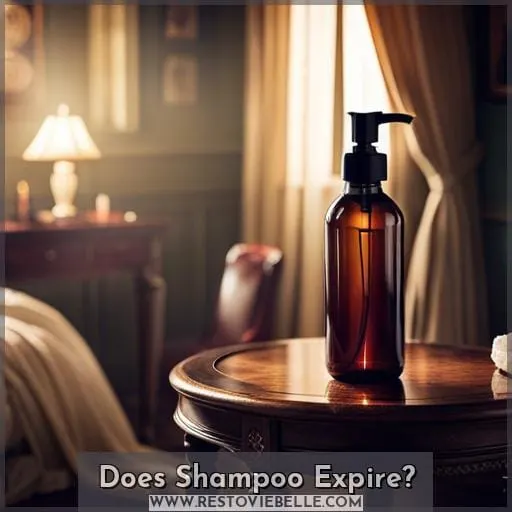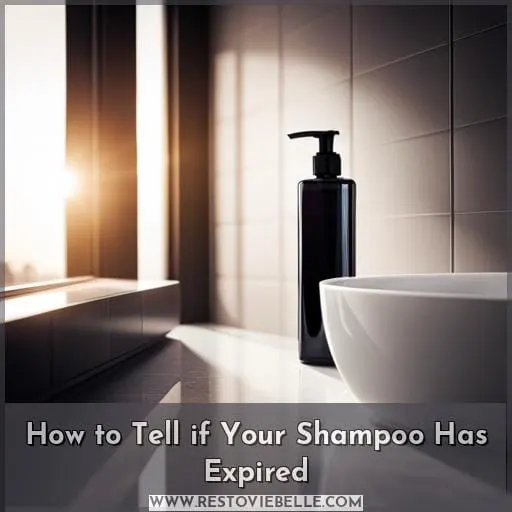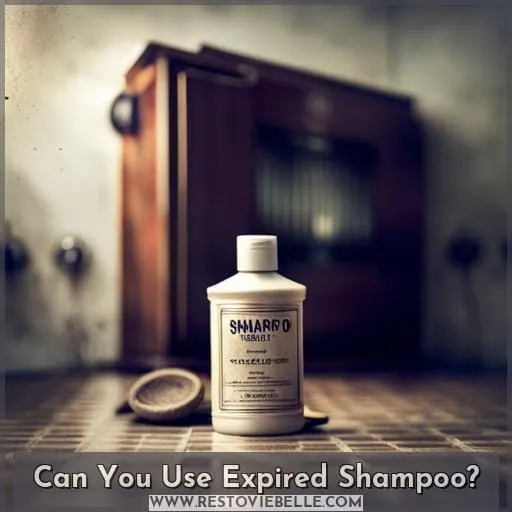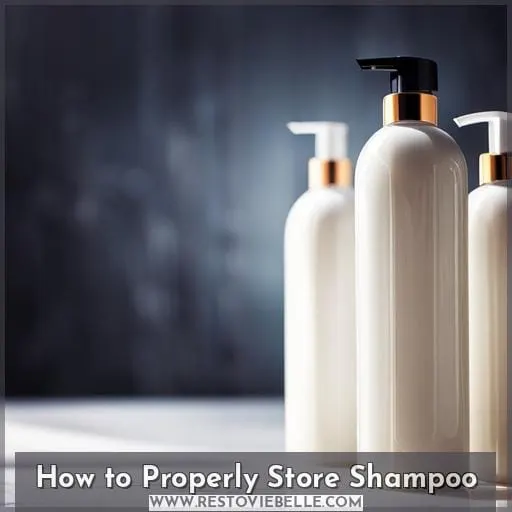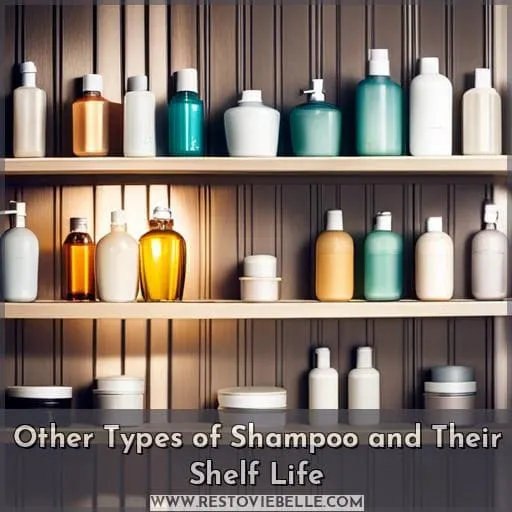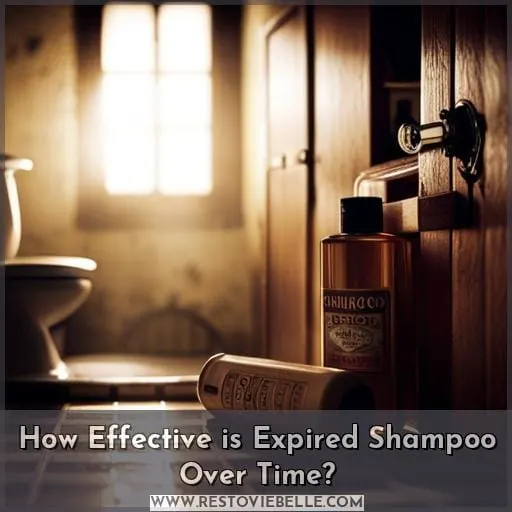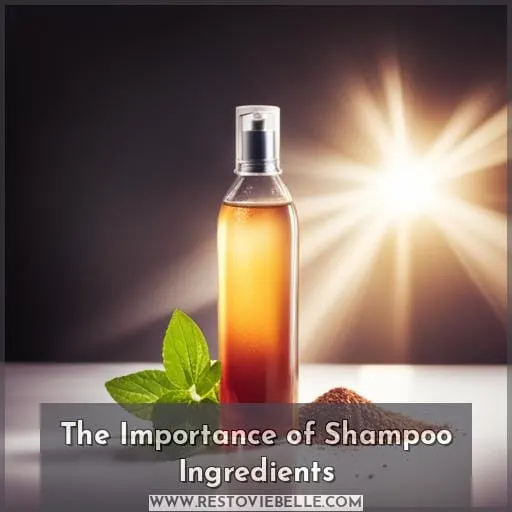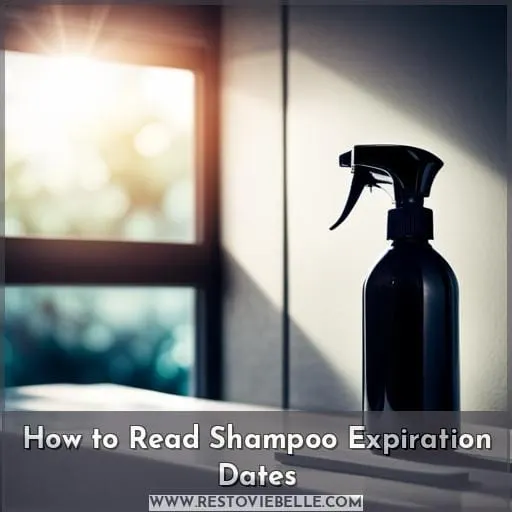This site is supported by our readers. We may earn a commission, at no cost to you, if you purchase through links.
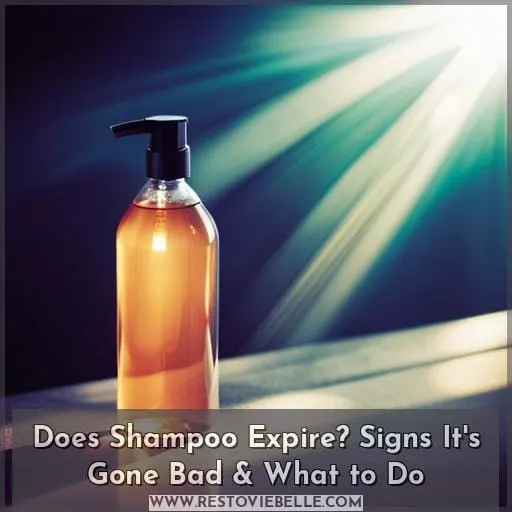 You open the shower door, catching a whiff of your shampoo. When was the last time you bought it – a year ago, maybe more? You examine the bottle closely. The color’s faded and there’s definitely a funky odor now. Does shampoo expire? You bet it does.
You open the shower door, catching a whiff of your shampoo. When was the last time you bought it – a year ago, maybe more? You examine the bottle closely. The color’s faded and there’s definitely a funky odor now. Does shampoo expire? You bet it does.
Once opened, bacteria and microbes invade, breaking down those sudsy cleansers over time. Check for changes in smell, texture, and color. If it passes those tests, use it up ASAP for squeaky clean hair.
But if it’s degraded, then it’s time to empower yourself and toss that expired shampoo.
Table Of Contents
- Key Takeaways
- Does Shampoo Expire?
- What is a Shampoo’s Shelf Life?
- How to Tell if Your Shampoo Has Expired
- Can You Use Expired Shampoo?
- How to Properly Store Shampoo
- Other Types of Shampoo and Their Shelf Life
- What Are the Side Effects of Using Expired Shampoo?
- How Effective is Expired Shampoo Over Time?
- The Importance of Shampoo Ingredients
- How to Read Shampoo Expiration Dates
- Conclusion
Key Takeaways
- Shampoo has an expiration date due to bacterial invasion after opening.
- Different types of shampoo have different shelf lives, with synthetic shampoos lasting longer than natural ones.
- Proper storage in cool, dark places away from sunlight and heat is crucial to extend the shelf life of shampoo.
- Using expired shampoo can lead to scalp irritation and dull hair.
Does Shampoo Expire?
You may be surprised to learn that even shampoo has an expiration date, so it’s important to pay attention to the manufacturer’s guidelines for keeping your hair looking and feeling its best.
The FDA does not regulate cosmetic shelf life, but brands use either a Period After Opening (PAO) suggestion or an expiration date on their products. PAO is represented by a container logo with a number such as 6M, 12M, 18M, or 24M, which indicates how long the product can last after opening.
Synthetic shampoos typically have longer shelf lives than natural ones due to preservatives preventing bacterial contamination in water-based shampoos. Opened bottles are more prone to bacteria growth leading signs of expired shampoo like separation of oil-based ingredients and fragrance changes.
When used past its ‘best before’ date on the label, expired shampoo should be discarded immediately as it can cause scalp irritation or dullness in hair health effects not worth risking over using expired shampoo!
Proper storage helps preserve quality: keep away from sunlight and heat sources while making sure lids are closed tightly.
What is a Shampoo’s Shelf Life?
You may be wondering how long a bottle of shampoo lasts before it expires. The shelf life for an unopened bottle is typically three years, while the shelf life for an opened bottle can range from six months to two years, depending on its preservatives and ingredients.
Shelf Life if Unopened
Unopened shampoo typically retains effectiveness for three years due to its preservative ingredients, which may be natural or synthetic. These ingredients help prevent the product from spoiling quickly. The FDA does not regulate cosmetic shelf life.
However, brands usually include either an expiration date or a Period After Opening (PAO) suggestion on their products.
Factors such as light exposure and improper storage can reduce the lifespan of unopened shampoo even further. Therefore, it’s important to pay attention to recommended best-before dates and store the shampoo properly.
When selecting your next bottle of shampoo, make sure you pick one with an appropriate shelf-life indicator before purchasing!
Shelf Life if Opened
When you open a bottle of shampoo, it will last 6 months to 2 years depending on the preservatives used. For instance, natural shampoos tend to have shorter shelf lives than synthetic ones due to their fewer preservative ingredients.
To maintain effectiveness and safety for your hair:
- Close the lid tightly after use.
- Store the shampoo away from direct sunlight and heat.
- Avoid contamination with other products or objects.
- Pay attention to best-before dates where possible.
Proper storage can help extend the life of opened shampoo bottles, but it’s important not to use expired product as this may cause dull hair, scalp irritation, or even bacterial infections in some cases!
How to Tell if Your Shampoo Has Expired
It’s important to evaluate your shampoo regularly, especially if you’re using a natural or sulfate-free product. To tell if it has expired, look for any changes in the scent and texture as well as clumpiness.
The best way to determine shelf life is by looking for an expiration date or Period After Opening (PAO) label on the bottle; this usually appears with a number like 6M, 12M, 18M, or 24M after it. If there’s no label present, then consider some expert opinions: smell changes can indicate that preservatives have broken down while texture goes from creamy to watery when ingredients begin separating due to age.
Using expired shampoo can lead to reduced efficacy and other side effects such as scalp irritation and hair loss – so make sure you check yours today!
Can You Use Expired Shampoo?
With shampoo, you may wonder if it’s safe to use past its expiration date. Manufacturers typically set an expiration date or a Period After Opening (PAO) suggestion represented by a container logo with a number like 6M, 12M, 18M, or 24M.
Expired shampoo can affect cleaning performance and irritate the scalp due to the loss of preservative potency. Visual clues such as clumpiness, discoloration, and smell are indicators that your product has gone bad.
The FDA doesn’t regulate cosmetic shelf life, but proper storage can help maintain the effectiveness of opened bottles. Keeping them away from sunlight and heat, as well as closing the lid tightly, can make them last up to two years, depending on the preservatives added.
Unopened products should be kept in cool, dark places, and paying attention to best-before dates would also ensure maximum efficacy when it comes to using shampoos beyond their stated expiry dates.
How to Properly Store Shampoo
To keep your shampoo in optimal condition, store it away from sunlight and heat, and close the lid tightly after each use.
- Ensure that you protect your shampoo from direct sunlight by storing it in a cool, dark place such as a cabinet or drawer.
- Make sure to always close the lid on your bottle or tube of shampoo securely after every use to prevent contamination with bacteria and other germs.
- Extend the shelf life of your shampoo by avoiding extreme temperatures. Both too hot or cold can cause the ingredients within the product to degrade faster than usual, leading to decreased effectiveness when used later on.
- Be mindful of expiration dates. Though these may not be explicitly listed for cosmetics like shampoos, they should still have one either printed directly onto them (in which case, follow this date) or stated via a Period After Opening (PAO) label (e.
- Lastly, consider auto refills for convenience discounts. Having fresh batches at regular intervals is important to maintain efficacy overall, including reducing the risk of potential skin irritation, dandruff, hair loss, and greasy locks associated with expired products.
Other Types of Shampoo and Their Shelf Life
You may be familiar with the traditional shampoo, but did you know that there are several other types of shampoo available? Dry shampoos, baby shampoos, dog shampoos, and organic or natural shampoos all have different shelf lives than regular hair cleansers.
Dry Shampoo
Surprise your strands with dry shampoo – a revolutionary way to revitalize hair for weeks on end! It’s made from natural ingredients, such as clay and cornstarch, which absorb oil and odors. Benefits include extended time between washes; ideal for those with oily scalps or little washing convenience.
Application is simple: shake the bottle vigorously before spraying onto scalp evenly at least 12 inches away. Alternatives exist like baking soda or baby powder, but these can be drying if used in excess.
Myths suggest it causes a buildup of bacteria, but studies have shown no difference compared to regular shampooing when applied correctly.
Dry shampoo not only adds volume but also refreshes without water – an incredible innovation that has revolutionized hair care!
Baby Shampoo
Baby shampoo is typically tear-free and has added moisturizers, so it can last slightly longer than other types of shampoos. It contains milder ingredients like aloe vera, chamomile extract, and glycerin to avoid irritating a baby’s eyes.
Baby shampoo safety is generally good as long as you check the list of ingredients for any known skin allergens.
Alternatives such as natural oils or soap bars can be used in place of traditional baby shampoos, which are also beneficial but come with their own drawbacks too. Benefits include an extra gentle cleanse on delicate hairs without stripping away essential oil from your scalp.
Plus, they may help reduce bacterial breakouts and fungal diseases better than regular products due to fewer chemicals in the formulation.
Even adults can enjoy these benefits by using Baby Shampoo!
Dog Shampoo
It’s important to check the expiration date of any dog shampoo you use for your pup, as it can lose its effectiveness over time. Popular brands are formulated with natural ingredients and additives that can help maintain pet hygiene and prevent allergies in dogs.
Even so, like beauty products, natural alternatives may not last as long due to fewer preservatives. Pay attention to the PAO label or recommended best-before dates when purchasing a bottle.
Ensure safe usage by closing lids tightly after use and storing away from sunlight or heat sources.
Properly care for your pup by reading up on shampoo tips & recommendations today!
Organic Shampoo
Organic shampoos are typically free of preservatives, so they may have shorter shelf lives than synthetic ones. However, their natural ingredients offer countless benefits: from a healthier scalp to improved hair strength and shine.
Organic shampoo also has an eco-friendly packaging option that minimizes waste and contributes to sustainability efforts. While expiry concerns remain with organic products due to the lack of preservatives, proper storage can extend its life up to two years or even more if unopened.
What Are the Side Effects of Using Expired Shampoo?
Using expired shampoo can have some serious consequences. Not only does it strip your hair of its natural oils, leaving it dry and dull-looking, but it also causes irritation or damage to the scalp as the ingredients break down.
The loss of preservative potency over time can make shampoo unsafe for use, as mold and bacteria could begin growing in the product. Additionally, chemical components such as fragrances or colorants may separate from each other due to aging, potentially harming the skin or hair.
These degraded ingredients can even penetrate through the outer layers of the scalp, leading to dandruff flakes, an itchy sensation, and greasy-looking strands.
How Effective is Expired Shampoo Over Time?
Unbeknownst to many, expired shampoo can be less effective over time. There are several factors at play when it comes to the effectiveness of your shampoo as it ages. From preservative potency loss and scalp issues to hair quality degradation and chemical changes.
- Loss of lather or cleaning ability.
- Strange odors.
- Separation of oil-based ingredients.
- Discoloration or texture alteration due to age-related breakdowns in the product composition.
- Changes in fragrance from oxidation reactions between ammonia compounds found in most shampoos.
Expired products put you at risk for scalp irritation, clumpy residue on strands, dullness—even major skin sensitivities if used long enough! So pay attention to the recommended best before dates listed on labels and carefully monitor product quality for optimal results with each use.
The Importance of Shampoo Ingredients
It’s important to understand the ingredients in your shampoo, as they determine its effectiveness over time. Natural shampoos tend to have a shorter shelf life due to fewer preservatives, while synthetic ones usually contain more and last longer.
These preservatives are essential for preventing bacterial contamination in water-based shampoos. Over time, these ingredients may degrade and cause changes in hair health, such as dullness or scalp irritation – a sign of expired shampoo.
Additionally, natural oils found in some formulas will separate out with age, which can also be an indication that it’s past its prime! Be sure to keep your products away from direct sunlight and heat sources too.
Pay attention not only to the expiration date but also to the recommended ‘best by’ dates on bottles if available. Function of Beauty custom haircare typically has 12-month shelf life guidelines set by the manufacturer, so consider auto refills every 3 months for convenience and discounts.
How to Read Shampoo Expiration Dates
Knowing how to read the expiration date on your shampoo is like having a map for taking care of your hair. Brands use either an expiration date or Period After Opening (PAO) label, which is represented by a container logo with a number (e.
To identify if it’s expired, you can follow these steps:
- Reading PAO labels: Look for the PAO symbol on the packaging, which indicates how long the product is safe to use after opening. The number next to the symbol represents the number of months. For example, if it says 6M, it means the shampoo is good for six months after opening.
- Checking odor and identifying clumps: If your shampoo smells off or has clumps, it may be a sign that it has expired. Expired shampoo can develop a foul odor or change in consistency, indicating that it’s no longer safe to use.
- Looking out for discoloration signs: Discoloration, such as a change in color or the presence of mold, is another indicator that your shampoo has expired. If you notice any unusual changes in the appearance of your shampoo, it’s best to discard it.
Using expired shampoo can have negative effects on your hair health. It can lead to dullness and scalp irritation due to the loss of preservative potency or the growth of bacteria in the product over time.
To ensure the longevity of your shampoo, it’s important to store it properly. Keep it away from heat and sunlight, as these factors can accelerate the expiration process. Additionally, make sure to tightly close the lid after each use to prevent air and moisture from entering the bottle.
Lastly, pay attention to the recommended best-before dates. This will help you know when it’s time to buy new bottles of shampoo and avoid using expired products on your hair.
Conclusion
It’s important to know how long shampoo stays good for, and the answer is that it depends on the type of shampoo. An average shelf life of an unopened shampoo bottle is three years, while opened shampoo bottles can last 6 months to 2 years, depending on preservatives.
However, it’s not always easy to tell when a shampoo has expired. Different types of shampoo may have different shelf lives. Signs of expired shampoo include separation of oil-based ingredients, changes in fragrance, reduced lathering, and odd odors.
To ensure maximum safety and effectiveness, properly store shampoo away from sunlight and heat, and pay attention to best-before dates. It’s also wise to consider auto-refills every 3 months to make sure you always have fresh shampoo on hand.
By understanding these guidelines, you can help keep your hair healthy and looking its best.

